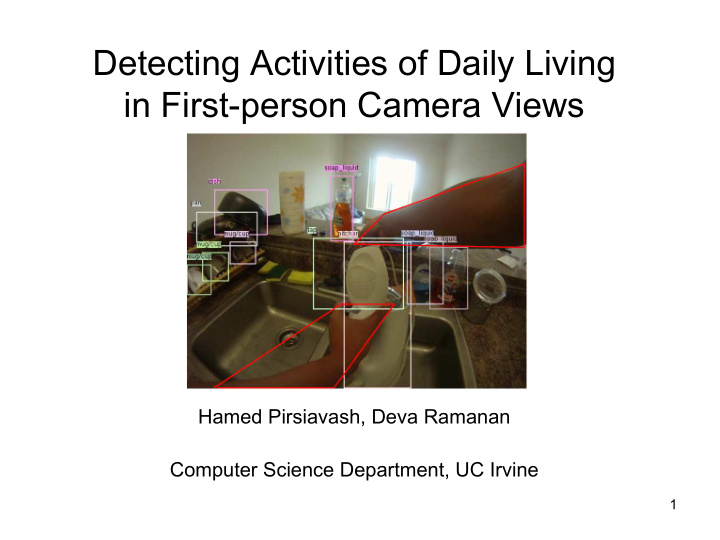



Detecting Activities of Daily Living in First-person Camera Views Hamed Pirsiavash, Deva Ramanan Computer Science Department, UC Irvine 1
Motivation A sample video of Activities of Daily Living 2
Applications Tele-rehabilitation Long-term at-home monitoring • Kopp et al,, Arch. of Physical Medicine and Rehabilitation. 1997. • Catz et al, Spinal Cord 1997. 3
Applications Life-logging So far, mostly “write-only” memory! This is the right time for computer vision community to get involved. • Gemmell et al, “MyLifeBits: a personal database for everything.” Communications of the ACM 2006. • Hodges et al, “SenseCam: A retrospective memory aid”, UbiComp, 2006. 4
Related work: action recognition There are quite a few video benchmarks for action recognition. UCF sports, CVPR’08 KTH, ICPR’04 Olympics sport, BMVC’10 Hollywood, CVPR’09 UCF Youtube, CVPR’08 VIRAT, CVPR’11 Collecting interesting but natural video is surprisingly hard. It is difficult to define action categories outside “sports” domain 5 5
Wearable ADL detection It is easy to collect natural data 6 6
Wearable ADL detection It is easy to collect ADL actions derived from medical natural data literature on patient rehabilitation 7 7
Outline • Challenges – What features to use? – Appearance model – Temporal model • Our model – “ Active ” vs “passive ” objects – Temporal pyramid • Dataset • Experiments 8 8
Challenges What features to use? Low level features High level features (Weak semantics) (Strong semantics) Human pose Space-time interest points Laptev, IJCV’05 Difficulties of pose: • Detectors are not accurate enough • Not useful in first person camera views 9
Challenges What features to use? Low level features High level features (Weak semantics) (Strong semantics) Space-time interest points Human pose Object-centric features Laptev, IJCV’05 Difficulties of pose: • Detectors are not accurate enough • Not useful in first person camera views 10
Challenges Occlusion / Functional state “Classic” data
Challenges Occlusion / Functional state “Classic” data Wearable data 12
Challenges long-scale temporal structure “Classic” data: boxing
Challenges long-scale temporal structure “Classic” data: boxing Wearable data: making tea Start boiling Do other things Pour in cup Drink tea water (while waiting) time Difficult for HMMs to capture long-term temporal dependencies
Outline • Challenges – What features to use? – Appearance model – Temporal model • Our model – “ Active ” vs “passive ” objects – Temporal pyramid • Dataset • Experiments 15 15
“Passive” vs “active” objects Passive Active 16
“Passive” vs “active” objects Passive Active 17
“Passive” vs “active” objects Passive Active Better object detection (visual phrases CVPR’11) Better features for action classification (active vs passive) 18
Appearance feature: bag of objects fridge stove TV SVM classifier fridge stove TV Video clip Bag of detected objects 19
Appearance feature: bag of objects Active Passive Active fridge fridge stove SVM classifier Active Passive Active fridge fridge stove Video clip Bag of detected objects 20
Temporal pyramid Coarse to fine correspondence matching with a multi-layer pyramid Inspired by “Spatial Pyramid” CVPR’06 and “Pyramid Match Kernels” ICCV’05 SVM classifier Video clip Temporal pyramid descriptor 21 time
Outline • Challenges – What features to use? – Appearance model – Temporal model • Our model – “ Active ” vs “passive ” objects – Temporal pyramid • Dataset • Experiments 22 22
Sample video with annotations 23
Wearable ADL data collection • 20 persons • 20 different apartments • 10 hours of HD video • 170 degrees of viewing angle • Annotated – Actions – Object bounding boxes – Active-passive objects – Object IDs Prior work: • Lee et al, CVPR’12 • Fathi et al, CVPR’11, CVPR’12 • Kitani et al, CVPR’11 • Ren et al, CVPR’10 24 24
Average object locations Passive Active Active objects tend to appear on the right hand side and closer – Right-handed people are dominant – We cannot mirror-flip images in training Passive Active Passive 25
Outline • Challenges – What features to use? – Appearance model – Temporal model • Our model – “ Active ” vs “passive ” objects – Temporal pyramid • Dataset • Experiments 26 26
Experiments Baseline Our model Space-time interest points Object-centric features (STIP) Laptev et al, BMVC’09 24 object categories Low level features High level features 27
Accuracy on 18 action categories • Our model: 40.6% • STIP baseline: 22.8% 28
Accuracy on 18 action categories • Our model: 40.6% • STIP baseline: 22.8% 29
Classification accuracy • Temporal model helps 30 30
Classification accuracy • Temporal model helps • Our object-centric features outperform STIP 31 31
Classification accuracy • Temporal model helps • Our object-centric features outperform STIP • Visual phrases improves accuracy 32 32
Classification accuracy • Temporal model helps • Our object-centric features outperform STIP • Visual phrases improves accuracy • Ideal object detectors double the performance 33 33
Classification accuracy • Temporal model helps • Our object-centric features outperform STIP • Visual phrases improves accuracy • Ideal object detectors double the performance Results on temporally continuous video and taxonomy loss are included in the paper 34 34
Summary Data and code will be available soon! 35
Summary Data and code will be available soon! 36
Summary Data and code will be available soon! 37
Thanks! 38
Recommend
More recommend